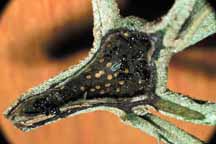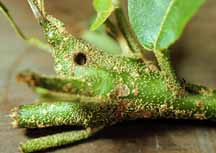The Relationship between Cordia alliodora and Ants in Costa Rica
Most of the text for this page is quoted directly from Longino (1996).
The genus Cordia occurs throughout the Neotropics, and two species, C. nodosa and C. alliodora, are specialized ant-plants (Wheeler 1942). Both species have pyriform cauline swellings at nodes where whorls of branches arise. These domatia are hollow and are usually inhabited by ants. Cordia nodosa is South American. Cordia alliodora is widespread in South America and also extends through Central America to southern Mexico. In Costa Rica, C. alliodora is the only myrmecophytic Cordia. It is a very common tree in anthropogenic habitats, occurring along roadsides and in pastures. On the dry Pacific side, the trees are usually small and bushy, with crooked trunks. On the wet Atlantic side, the trees are tall and straight. It has the common name "laurel" and is considered a valuable timber tree (Opler & Janzen 1983).
Individual Cordia trees usually harbor a number of ant species. In small saplings or stump sprouts, many species of founding queens may be found dispersed in the available nodes. In mature trees, live nodes typically house species distinct from those housed in dead nodes. Most often a dominant colony occupies most but not all of the live nodes, with smaller colonies of other species occupying the remaining nodes. Alternatively, a single dominant colony may not be recognizable. Instead, the tree may contain a mosaic of numerous colonies, or many nodes may be unoccupied.
The species of ants in individual trees are a subset of the surrounding community of available ant species. As with insect herbivores, those species exhibit a broad range of host specificity. A large number of species of generalist inhabitants of dead stems may be available to occupy dead nodes of a C. alliodora tree. In the Neotropics these include members of the genera Crematogaster, Dolichoderus, Tapinoma, Camponotus, Leptothorax, Pseudomyrmex, Brachymyrmex, Zacryptocerus, Paratrechina, and others. A smaller number of generalist inhabitants of live stems may be available to occupy live nodes, and part or all of a crown may be inhabited by one or more colonies of these generalists. These include some species of Crematogaster, Pseudomyrmex, Zacryptocerus, and Azteca. These live stem generalists may have small colonies in one or a few nodes, or they may form large, dominant colonies that occupy much of the tree. Generalist inhabitants of C. alliodora show no obvious specialization for use of the plant. They are often scavengers and omnivores, and forage both on and off the plant. Species that form large, dominant colonies are not necessarily restricted to a single tree. Their large, polydomous colonies may extend into the surrounding vegetation.
In contrast to these generalists, a smaller pool of available colonists make specialized use of C. alliodora. They usually form large, dominant colonies, occupying most or all of a live crown, and they are typically the most common inhabitants in an area. Their nest space is entirely within a single tree (or tight cluster of trees if from stump sprouts), and they do not forage off the tree. In spite of their local abundance in C. alliodora trees, they are never found nesting elsewhere, which suggests that they are obligate host specialists. The Azteca pittieri complex and, at least locally, Azteca JTL-003 appear to be the dominant or primary host specialists in Costa Rica.
Earlier works (Wheeler 1942, Opler & Janzen 1983) report A. longiceps as an obligate Cordia ant. Longino (1996) showed this to be an error caused by early misidentifications. longiceps is actually a specialist inhabitant of Triplaris melaenodendron.
Not all host specialists are dominant ants. The most ubiquitous inhabitant of C. alliodora is Zacryptocerus setulifer (Emery). This myrmicine ant has phragmotic soldiers which plug the entrance to the nest with their perfectly circular heads. They are inconspicuous and timid ants. They are capable of coexisting in the same tree with any of the above dominant ants, and they can live in trees without a dominant ant colony. They appear to be an obligate inhabitant of C. alliodora; I have never encountered them anywhere else. Nearly every C. alliodora population I have examined in Costa Rica has had Z. setulifer in some of the nodes.
Two ant species, Pseudomyrmex viduus (Fr. Smith) and Azteca beltii, show a combination of traits of host specialists and host generalists. They exhibit the behavior of a specialized plant-ant: they confine their nesting and foraging territory to the host tree itself, and, in the case of P. viduus, they may aggressively defend their host tree. However, they are generalists with respect to which species of host plant they inhabit. Both species can be found in different genera of well-known ant-plants (e.g., Cecropia, Triplaris, and Cordia), and A. beltii has also been found in other species of non-ant-plants.
Most trees in populations of C. alliodora are occupied by members of the A. pittieri complex, with Zacryptocerus setulifer, Azteca beltii, and Pseudomyrmex viduus as less common background elements. This is well-illustrated with data from an elevational transect. The road from the Pan-American Highway to Monteverde passes through an elevational gradient from 200m to 1400m, all of which is in pastures and second growth vegetation. Cordia alliodora trees are common in patches along the roadside, starting at 400m around Guacimal, and extending to about 900m, along 10km of road. In 1984 and in 1991, I sampled ants from C. alliodora trees along this road. Azteca beltii occurred occasionally throughout the transect. Pseudomyrmex viduus occupied patches of trees near 500m. I found Azteca JTL-003 in two patches of trees around 500m, and collected the only known samples of this species. Members of the A. pittieri complex occupied the great majority of trees. There appeared to be two different biological species in the A. pittieri complex along this transect, with a lowland form changing to an upland form around 500m elevation.
It is unknown what impact parasitoids may have on community dynamics and structure. Founding A. pittieri complex queens are often attacked by parasitoid larvae inside Cordia nodes. They are probably larvae of Conoaxima (Eurytomidae); they are similar to larvae of Conoaxima I have observed attacking Azteca queens in Cecropia (Longino 1991). At La Selva Biological Station I have observed larvae feeding externally on dead queens, and in two cases parasitoid pupae were on the walls with dead queen remains in the bottom.
Literature Cited
Longino, J. T. 1991. Taxonomy of the Cecropia-inhabiting Azteca ants. Journal of Natural History 25:1571-1602.
Longino, J. T. 1996. Taxonomic characterization of some live-stem inhabiting Azteca (Hymenoptera: Formicidae) in Costa Rica, with special reference to the ants of Cordia (Boraginaceae) and Triplaris (Polygonaceae). Journal of Hymenoptera Research 5:131-156.
Opler, P. A., and D. H. Janzen. 1983. Cordia alliodora (Laurel). Pp. 219-221 in D. H. Janzen, eds. Costa Rican Natural History. University of Chicago Press, Chicago.
Wheeler, W. M. 1942. Studies of neotropical ant-plants and their ants. Bulletin of the Museum of Comparative Zoology, Harvard 90:1-262.
Page author:
John T. Longino, The Evergreen State College, Olympia WA 98505
USA. longinoj@evergreen.edu
Date of this version: 12 December 1997
Previous versions of this page:
 Go back to top
Go back to top



